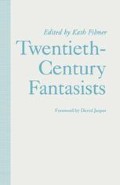Abstract
Between about 1890 and 1914, Pan the goat-god enjoyed a popularity among creative artists, especially in Britain, which was quite unprecedented in the postclassical world and which crossed the frontiers increasingly being set up by Modernist experiment between ‘high’ and ‘popular’ culture. On the stage, for example, Nijinsky first performed L’Après-midi d’un faune in 1912 and Pan appeared in London in 1914 in the Ballets Russes production of Ravel’s Daphnis and Chloe. But the theatres catered also for middlebrow taste: Lionel Monckton and Howard Talbot’s hugely successful operetta The Arcadians (1909) contained a coloratura invitation (written by Arthur Wimperis) to ‘follow, follow, follow’ ‘when the pipes of Pan are calling’ (qtd. in Hyman 188), while Edward German’s Merrie England (1902; lyrics by Basil Hood) had Sir Walter Raleigh and Bessie Throckmorton warbling about the homely blisses of love in a cottage:
Come, come to Arcadie!
Bring your Phyllis, happy Corydon!
Learn together, if you can,
The simple tunes of Piper Pan!
(Hood 14)
Access this chapter
Tax calculation will be finalised at checkout
Purchases are for personal use only
Preview
Unable to display preview. Download preview PDF.
Works Cited
Barrie, James. Peter Pan, or, The Boy Who Would Not Grow Up (London: Hodder and Stoughton, 1928).
Batchelor, John. ‘Chesterton as an Edwardian Novelist’, The Chesterton Review 1 (1974), 23–35.
Beerbohm, Max. ‘Hilary Maltby and Stephen Braxton’, Seven Men and Two Others (London: Oxford University Press, 1966), 45–94.
Carpenter, Humphrey. Secret Gardens: A Study of the Golden Age of Children’s Literature (London: Unwin Paperbacks, 1987).
Chesterton, G.K. The Napoleon of Notting Hill. A G.K. Chesterton Omnibus, 2nd edn (London: Methuen, 1942), 1–200.
Chesterton, G.K.. The Man Who Was Thursday, A G.K. Chesterton Omnibus, 2nd edn (London: Methuen, 1942), 201–407.
Doyle, Arthur Conan. ‘The Copper Beeches’, The Adventures of Sherlock Holmes (London: John Murray, 1960), 275–302.
Forster, E.M. ‘The Story of a Panic’, Collected Short Stories (Harmondsworth: Penguin Books, 1970), 9–33.
Grahame, Kenneth. ‘The Rural Pan’, Pagan Papers, 6th edn (London: John Lane, 1898), 63–71.
Grahame, Kenneth. The Wind in the Willows (London: Methuen, 1932).
Green, Peter. Kenneth Grahame 1859–1932: A Study of his Life, Work and Times (London: John Murray, 1959).
Hewlett, Maurice. Pan and the Young Shepherd, A Pastoral (London: Heinemann, 1906).
Hewlett, Maurice. The Letters of Maurice Hewlett, Laurence Binyon (ed.) (London: Methuen, 1926).
Hood, Basil. Libretto, Merrie England music by Edward German (London: Chappell, n.d.).
Howkins, Alun. ‘The Rural World and Its Representation’, The Edwardian Era, Jane Beckett and Deborah Cherry (eds) (London: Phaidon Press and Barbican Art Gallery, 1987), 138–47.
Hyman, Alan. Sullivan and His Satellites: A Survey of English Operettas 1860–1914 (London: Chappell/Elm Tree Books, 1978).
Machen, Arthur. Far Off Things (London: Martin Secker, 1922).
Machen, Arthur. The Great God Pan, Tales of Horror and the Supernatural (London: Richards Press, 1949), 61–115.
Marsh, Jan. Back to the Land, The Pastoral Impulse in Victorian England from 1880 to 1914 (London: Quartet Books, 1982).
Maugham, W. Somerset. Cakes and Ale, or, The Skeleton in the Cupboard (London: Dent, 1946).
Merivale, Patricia. Pan the Goat-God: His Myth in Modern Times, Harvard Studies in Comparative Literature 30 (Cambridge, Mass.: Harvard University Press, 1969).
‘Saki’ (H.H. Munro). ‘The Music on the Hill’, The Short Stories of Saki (London: John Lane, 1933), 179–85.
Stephens, James. The Crock of Gold (London: Macmillan, 1924).
Stevenson, Robert Louis. ‘Pan’s Pipes’, Virginibus Puerisque, vol. 22 of Collected Works, Skerryvore Edition (London: Heinemann, 1924), 143–7.
Williams, Raymond. The Country and the City (London: Hogarth Press, 1985).
Editor information
Editors and Affiliations
Copyright information
© 1992 Palgrave Macmillan, a division of Macmillan Publishers Limited
About this chapter
Cite this chapter
Dingley, R. (1992). Meaning Everything: The Image of Pan at the Turn of the Century. In: Filmer, K. (eds) Twentieth-Century Fantasists. Palgrave Macmillan, London. https://doi.org/10.1007/978-1-349-22126-4_5
Download citation
DOI: https://doi.org/10.1007/978-1-349-22126-4_5
Publisher Name: Palgrave Macmillan, London
Print ISBN: 978-1-349-22128-8
Online ISBN: 978-1-349-22126-4
eBook Packages: Palgrave Literature & Performing Arts CollectionLiterature, Cultural and Media Studies (R0)

